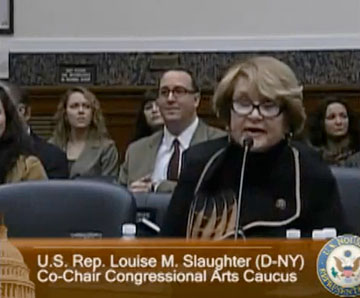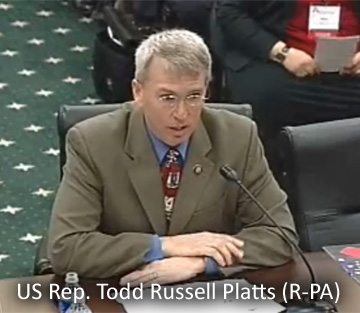
Rep. Louise Slaughter speaks about the economic and employment impact of the arts and music industry on March 26, 2009 (via the Education and Labor Committee's YouTube channel).
A few months ago, I went to the Bronx for a studio visit with an accomplished artist, John Fekner, whose personal brand of street graphics helped define a tumultuous era in New York’s cultural life in the late 1970s and early 80s. He explained to me something that people of my generation may not remember, namely that in the early 1980s federal funds for the arts quickly dried up and countless arts programs went into crisis and eventually closed their doors. It was a difficult time, he said, and the decline in federal funding seemed to continue until the mid-1990s, when federal arts funding became a lightning rod issue as the ICA’s exhibition of Robert Mapplethorpe photography became the poster child for an art establishment that reputedly didn’t represent the values of middle-class Americans. The resulting controversy made the federal agency that allocates federal arts money, the National Endowment of the Arts (NEA), a target for national disdain.
If the late 1990s were the nadir of federal arts funding in America (funding hit an all-time low of $97.6 million in 2000) since the turn of this century, the numbers have started to creep up. This year, the NEA received $155 million in funding, with an additional $50 million as part of President Obama’s stimulus plan.
But these small victories are not easy ones for the arts community. Fortunately, the arts sector has two champions in Congress who co-chair the House Arts Caucus, Rep. Louise Slaughter (D-NY) and Rep. Todd Russell Platts (R-PA), both of whom I spoke to separately via phone about the state of federal arts funding today.
A longtime art advocate and a powerful voice in Congress, Rep. Slaughter of Western New York mentioned that while President Ronald Reagan “zeroed out arts funding,” it was also the period when the House Arts Caucus was established. “The Mapplethorpe controversy was a major problem in the 1990s and in 1994, we had people who were being elected to Congress to kill the NEA,” she explains. “They thought it was decadent and didn’t fit their pattern of decency.”
After the turmoil and culture wars of the 1990s, things changed after the 1999 elections. According to Rep. Slaughter: “[Arts funding] did better under President Bush and now with President Obama, we have a more sympathetic ear.”

Rep. Todd Russell Platts speaks at National Arts Advocacy Day in Washington, DC (via Americans for the Arts' YouTube channel
Slaughter’s co-chair, Rep. Platts, mentions that in the last nine years arts funding has risen by about 50%. “Changes in the way the NEA operates has helped and by making [funding] a less partisan issue, it will help it to grow,” he says. “Depoliticizing the NEA and its approach and making it non-partisan and merit-based were all positive. This way we can ensure that all corners will support it. Today, we can say that all congressional districts have benefited from the funding of the arts and the NEA has done a great job at not focusing only on the major urban centers.”
Rep. Slaughter also mentions this important geographic shift in where arts funds go as a key point for the recent success: “Before, all funding was granted only to New York, Chicago, and LA, where most touring companies were based. But now it is guaranteed that all 50 states are funded.”
If federal arts funding was once a driving force in funding everything from regional museums to avant-garde projects, the consensus seems to be that federal funds will be easier to find if they are tied to an impact on early education. Rep. Platts‘ passion for the arts stems mostly from his experience as a father. “I believe in the importance of arts in the broad quality of life for our citizens, but particularly for our youth,” he explains. “There’s broad data to prove that the exposure to arts translate to interest and success in other aspects of their academics and lives.”
Rep. Slaughter says data supports the funding of the arts and points out that many companies, including those not traditionally associated with the arts like Westinghouse, say they prefer to hire people with an arts background. She also explained that school data also demonstrates the importance of exposure to the arts at a young age: “If you have art in high school, reading scores go up.” She spoke about the case of Rankin Elementary School in Gaston County, NC, where teachers use visual and performing arts to help teach subjects such as math, science, history, and language. As a result, the school’s state exam scores rose 8 percentage points. She offered a long list of data about the size of the arts economy ($166.2 billion of yearly economic activity) and the number of jobs the sector provides nationally (5.7 million). And she proudly points out that more full-time jobs are supported by the nonprofit arts than they are in accounting, public safety, law, and just slightly fewer than elementary school education.
If the case for arts funding in America is being made with more precision today than ever before, it is most likely thanks to organizations like Americans for the Arts, which was created in 1996 as a result of the merger of a number of smaller organizations. Its advocacy work has helped make the case on paper for a rejuvenation of national interest in the arts and seems to be effective.
But if the data and numbers help make the case in Congress, personal stories about the importance of the arts often seal the deal for arts advocates. I asked both Arts Caucus co-chairs about their own memories that helped form their enthusiasm. Rep. Slaughter was quick to reply that her passion is rooted in her Kentucky childhood, when books were hard to come by. “The books that I read lifted me over that mountain and showed me the world out there,” she says. “I was able to see the value of looking at things. It makes us better citizens.”
Rep. Platts shared his own formative experiences: “I have fond memories of attending performances as a child. As an arts student, I was challenged in my own personal art abilities,” he jokes. “But what had the most profound impact on me is becoming a dad and seeing the effect on my children.”
Today, Rep. Slaughter represents a district that includes exemplary regional museums, including the Albright-Knox Art Gallery in Buffalo and the George Eastman House in Rochester, and a number of smaller museums that make the area rich in visual arts resources. Rep. Platts represents a district in south central Pennsylvania which has a number of institutions that support the local arts community, including the Strand-Capitol Performing Arts Center in York, PA.
As part of the phone interview, I asked the congressional co-chairs some questions artists and culture aficionados in my Facebook network wanted me to ask when I appealed to them for ideas. The most pressing question was: do they ever think individual artists, and not only institutions, will ever receive direct funds again?
“I’ve not seen much of a push for any real changes to fund individual projects,” Rep. Platts responded. Rep. Slaughter was more realistic: “Until the funding goes up, we can’t even approach that question.”
And how about the creation of a Secretary of Culture, which was an idea originally suggested by music producer Quincy Jones on WNYC on November 14, 2008 and opined by former chair of the National Endowment for the Humanities William Ferris in a New York Times Op-Ed back in December?
“I don’t know if we need more bureaucracy,” Rep. Slaughter said. Rep. Platts also didn’t see a point to a new position.
I asked the two co-chairs if they thought arts organizations were effective at making the case for their own funding and what they do for our country. Should artists be doing anything to ensure that arts funding is a priority for our elected officials?
“No, I don’t think they are doing anything wrong,” Rep. Slaughter said. “And artists don’t owe us a thing. It’s incredible how they make a living.”
Rep. Platts took a different approach and explained that, “the more personal the communication to members of Congress the better.” He seemed to discourage organizational lobbying and wanted individuals to relay their own stories to their elected officials which, he said, makes a big difference to people like him.
“It could be teachers who can see the difference to their students in core subjects because of the impact of the arts. This is very powerful information. People should not hesitate in communicating not only if they support funding in the arts but why they do,” he said.
Rep. Slaughter also valued personal stories and she peppered our conversation with stories she heard from individuals who valued the arts. “When a little theatre goes dark I take it personally,” she says.
They both saw a positive future for arts funding in the country, though Rep. Platts emphasized that the biggest obstacle today is the economy. Rep. Slaughter explained why she thought there is a more rosy perception towards federal arts funding: “There’s a shift because we are understanding the economic benefits and not just their impact on the arts.”
She also summed up the argument in favor of arts funding most succinctly: “people who create don’t destroy.”
*****
Also of interest online—view the following National Arts Advocacy Day (May 1, 2009) videos from the Americans for the Arts’ YouTube channel, when both Arts Caucus Co-Chairs spoke to Congress as to why the arts should be federally funded: Rep. Louise Slaughter (D-NY) and Rep. Todd Russell Platts (R-PA).




Pingback: Understanding US Federal Arts Funding: By the Numbers & Interviews with House Arts Caucus Co-Chairs — Hrag Vartanian
Pingback: A QUICK SUMMARY OF FEDERAL ARTS SUPPORT « Economic Turmoil and Change